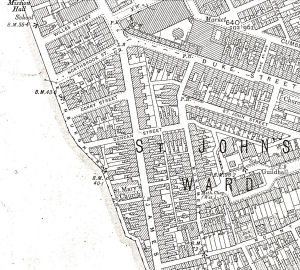|
OLD DEVONPORT
. UK |
||
|
© Brian
Moseley, Plymouth Webpage created: April 08, 2017 Webpage updated: April 19, 2021 |
||
|
ROADS AND STREETS IN OLD DEVONPORT JAMES STREET James Street, a continuation southwards of Catherine Street, ran from the junction of Duke Street and Northbrook Street to Mutton Cove. It will be seen in the map below that the properties on the eastern side of James Street, in Devonport, between Duke Street and Duncan Street, were larger and more regularly shaped than those lower down the Street or on the opposite side. This is because they were part of the 1890s scheme to provide new Workmen's Dwellings.
The larger Workmen's
Dwellings can be seen at the top Mr H W Whitfeld, chairman of the Housing of the Working Classes Committee, laid the memorial stone for this development on Friday October 13th 1899. The work of demolishing the 'wretched hovels and dilapidated buildings' of Bragg's Alley and erecting these two new blocks of properties was completed in September 1900. The first block occupied faced up Catherine Street and consisted of three shops on the ground floor, with stores behind, each with three residential flats on the first floor approached by a separate entrance and staircase. One flat had a living room and a bedroom while the second and third had two bedrooms in addition to the living room. Each flat had its own scullery and lavatory. The second floor repeated this layout. Between that block and Duncan Street was the second block of six properties. With the exception of the last one, on the corner with Duncan Street, each had a street frontage of 40 feet. Again with the exception of the last property, each had two residential flats on each of ground, first and second floors. The ones of the ground floor had a living room and one bedroom while those of the other two floors each had a living room and two bedrooms, all with their own scullery and lavatory. The last property was similar but being slightly larger than the others it also contained a lock-up shop. All the buildings were constructed of local brick with Portland cement facings. The frontages in James Street were picked out with square pilasters of Portland cement, as were the entrance ways. The staircases were fire-proof. When completed, there would be accommodation for 141 people. The buildings were designed by Devonport's Borough Surveyor, Mr J Burns, and constructed by Mr S Roberts, of Plymouth, at a cost of around £8,000. The total cost was said to be £14,700. The rent imposed as a result amounted to between five shillings and 6s 9d per week for a bedroom, sitting-room and scullery. It was stated that the ideal rent would be three shillings but the price of the land made such a prospect unlikely. During the stone-laying ceremony praise was heaped upon Mr Whitfeld, of whom the Mayor, Mr W Hornbrook, said: 'Mr Whitfeld had no other reward, for he had sought to gain nothing but the good-will and love of the boys and girls and men and women of Devonport'. The principal buildings existing in 1914 were the Workmen's Dwellings between Duke Street and Duncan Street, the Moravian Chapel, the Anglican Church of Saint Mary the Virgin, the Roman Catholic Church of Saint Michael and Saint Joseph, and the Schools attached to the Roman Catholic Church.
The Impregnable Inn, James Street, in January
1959. There were a number of Licensed Landmarks: the Queen and Constitution Inn on the corner of Duncan Street, the Oporto Inn on the corner of Mount Street, the New Pier Vaults on the western side of the Street, and the Impregnable Public House. Principal businesses in James Street in 1914 were Mr W Bishop, plumber and gas fitter, Mr C Harvey, baker, Mr J Soper, fish dealer, Mr T F Stidever, pawnbroker, Messrs Ash and Son's cork and wine and spirit merchants, Mr A W Dubbin's mineral water manufactory, and Miss Martin, the news agent. There were several general shops and even a toy shop.
|
||

